Please click here to access the main AHDB website and other sectors.
- Home
- Knowledge library
- Pests
Pests
The glasshouse is an artificial environment which provides ideal conditions; warm, high humidity, protection from the outdoor elements and a plentiful food source all year round.
The amount of pests that can be tolerated in a particular system will depend on the crop, and to some extent what part is marketed. If the whole plant, for example leafy greens or in ornamental production, is retailed less overall damage can be tolerated than in, for example a pepper or tomato crop where only the fruit (and sometimes the fruit truss) is sold.
Integrated pest management forms the backbone of most modern pest control systems in glasshouses. Monitoring is the primary focus with cultural, biological and the last resort of chemical controls in the strategy.
Some of the more common pests encountered are:
- Red spider mite, is quite small the adult females measure about 0.4 mm, it sucks the contents of leaf cells and can feed on many plants. Although individual damage is microscopic, many (and particularly hyper-necrotic type) can have a significant impact.
- Tuta absoluta (South American leafminer), larvae burrow and feed in the surface tissues affecting all parts of the plant.
- Mealybugs, are about 4 mm long covered in waxy threads and found in protected parts of plants. They suck sap and excrete honeydew which can be colonised by sooty moulds.
- Whitefly, another sap feeding pest that excretes honeydew, can be seen as small (1.5 mm) white winged insects often in a group which form a white cloud when disturbed, can transmit virus.
- Aphids, sap sucking pest with many species in the UK, up to 7 mm long they cause stunted and distorted growth, also excrete honeydew and can transmit viruses.
- Thrips, can be a major pest in glasshouses, slender bodies up to 2 mm in length, again sap sucking causing silvering leaves, stunted growth, and senescence of flowers.
- Caterpillar, moth larvae can be occasional pests feeding on leaves and fruit.
- Russet mite, microscopic yellow/orange conical shaped mite that cause damage to fruit, stems and leaves.
Growers are recommended to consult their AHDB Crop Walker guides or apps as an aid to identifying unfamiliar pests.
Red Spider Mite
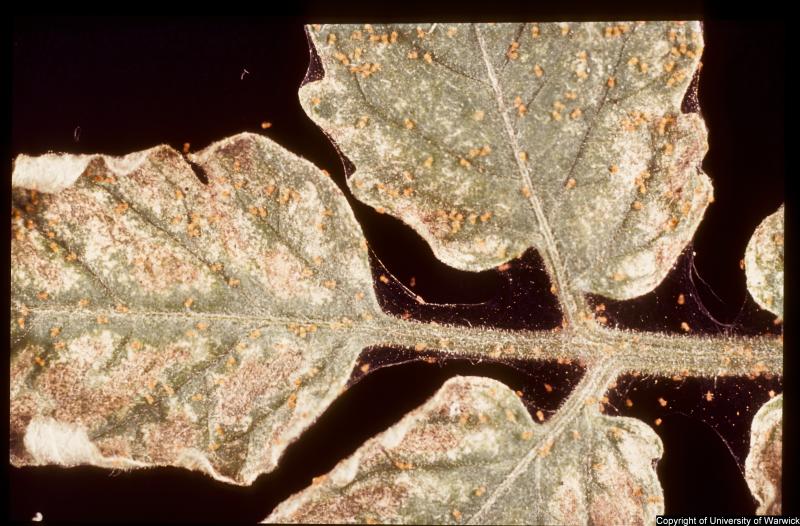
Tuta absoluta
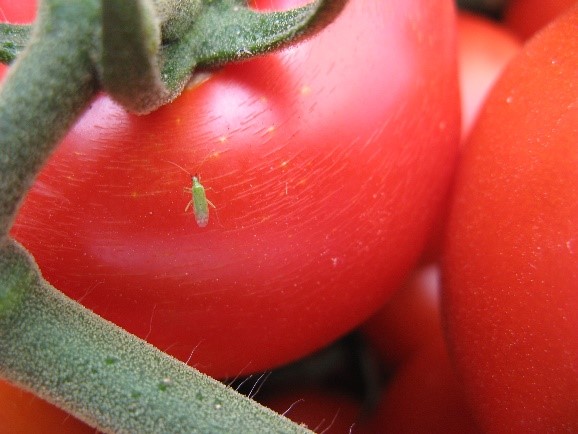
Tuta absoluta arrived in the UK in 2009 and by 2012 was causing serious losses for some tomato growers. The main issue was spread from site to site by the transfer of adult moths in produce trays etc. AHDB Horticulture projects PC 302, PC 302b, PC 302c and PC 302d developed a new IPM strategy based on the predator, Macrolophus pygmaeus, integrated with the IPM compatible insecticides, spinosad (Conserve) and chlorantraniliprole (Coragen). PE 002 ‘Development rate of Tuta absoluta under UK glasshouse conditions’, fed information on optimum temperature for development and egg, larvae and moth survival rates into the overall control strategy. A summary Factsheet from the five projects was produced, 02/14 ‘A robust IPM programme for Tuta absoluta’.
A diagnostic sheet to help differentiate between leafminers in the glasshouse was also compiled 03/10 ‘Tomato leafminers’. PE 028 ‘Tuta absoluta: Investigating resistance to key insecticides and seeking alternative IPM compatible products’ was initiated in 2015 and suggested some modifications to the control programme. More recently Tuta has been found to become resistant to some chemical controls and further work is being undertaken to advance the strategy. The AHDB Horticulture studentship project (2016-20) CP 162 ‘Combating insecticide resistance in the tomato leafminer, Tuta absoluta’continues to investigate this problem.
There has been limited specific AHDB work on end of season clean-up but Tuta is another key pest to eliminate prior to establishing a new crop. Research published in 2015 in the Journal of Pest Science ‘Overwintering potential of the invasive leafminer Tuta absoluta (Meyrick) (Lepidoptera: Gelechiidae) as a pest in greenhouse tomato production in Western Europe’ concluded that T. absoluta is likely to successfully overwinter between two successive tomato crops in commercial greenhouses in Western Europe. Adults showed better cold hardiness than larvae and pupae.
Mealybugs
AHDB Horticulture funded work on mealybugs in 1998, PC 161 ‘Protected tomato: Integrated control of mealybugs’. Spread within infested nurseries occurred when irrigation lines or packing boxes were moved from mealybug infested areas to new areas without first being cleaned and sterilised. Crop monitoring confirmed that individuals survived between crops as eggs, most commonly located on the concrete bases (dollies) of roof supports, on dwarf walls and on irrigation drippers. The numbers of nymphs emerging onto the new crop were reduced by painting the concrete dollies in the affected areas with a thick paint or glue, covering them in polythene and sealing all joints with glue. Although effective, this method was labour intensive and expensive. An AHDB Factsheet was produced 25/00 ‘Mealybugs on protected tomato crops’, that summarised the project work.
In 2006 part of the remit of PC 240 ‘Organic tomato: Development and implementation of a robust IPM programme’ was to investigate mealybug control. As there had been so much difficulty in achieving remedial control during the growing season, more emphasis was placed on minimising the numbers of mealybugs that survived between crops and successfully colonised the new plants. A new strategy was designed and successfully evaluated in 3 ha of commercial crops. This led to the production of a mealybug control protocol.

Whitefly
Tobacco whitefly (Bemisia tabaci) is a notifiable pest and a major vector of virus. A plant pest factsheet on this pest has been prepared by Fera. AHDB Horticulture project PO 003 ‘Control of tobacco whitefly on poinsettia’ in 2010 found a range of products that were suitable to control whitefly early in the season recommending that coverage of the leaf undersides was critical for control of physical acting products.
Glasshouse whitefly (Trialeurodes vaporariorum) biological control has relied on the release of the parasitic wasp Encarsia formosa. AHDB Horticulture project PC 251(2006) ‘AYR Tomato production: Phase 1 of the development and implementation of a robust IPM programme’ investigated control of the major tomato pests under artificial lighting. Whitefly was found to be most difficult pest to control with chemical methods having to be employed. Herb production can also be affected by this species, AHDB Horticulture project PC 178 (2000) ‘Protected herbs: Control of glasshouse whitefly and leafhoppers within IPM programmes’ produced an AHDB Horticulture Factsheet 05/01 with grower guidance for season through control.
There is also a useful AHDB Horticulture Factsheet ‘Control of whitefly in protected ornamental crops’ to differentiate the two species.
Whitefly do not have any specific overwintering strategies but can survive if there is some plant material (including some weeds) remaining in the glasshouse. They will be fairly inactive in the winter but can multiply rapidly in spring, so thorough removal of vegetation is critical to ensure there is no food source to allow carry-over.

Aphids
AHDB Horticulture have funded many projects across the various crops and cropping systems to investigate aphid control. In the glasshouse sector the focus has been on biological controls. Specific AHDB Horticulture Factsheets have been produced to aid control, for example, in lettuce (11/11 ‘IPM strategies for the control of aphids’) and strawberries (26/05 ‘Aphids and their control on strawberry’). The effects of hyperparasitoids on aphid populations have been investigated in pepper production. There is a useful Canadian Factsheet to aid in identification of species typically found in glasshouses and control measures, although common names may differ from the UK. An AHDB Horticulture identification card ‘Aphids commonly found in protected lettuce’ can be requested.
‘A review of aphid control in peppers’ (2015) PE 027 has highlighted the need for good hygiene levels from growers surveyed and in the published literature. In addition, growers described the importance of removing dead plants and steam cleaning the glasshouse to remove any overwintering aphids. Several growers also reported problems with ants protecting aphid populations from predators and parasitoids and as a consequence reducing the overall efficacy of biological control programmes.
Most of the species described do not produce eggs so will only survive if there is host plant material. Some species are able to produce overwintering eggs so again end of season cleaning is important.
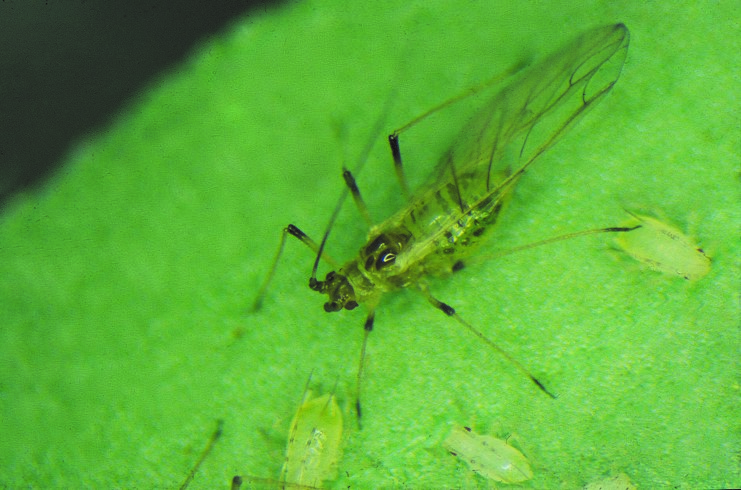
Western flower thrips (Frankliniella occidentalis) and Onion thrips (Thrips tabaci)
Thrips are not only an important pest in their own right but also a key vector for the spread of virus. Again they have been the focus of many research projects looking at control in the season, particularly in strawberries but also cucumber, peppers and protected ornamentals. More novel management methods such as use of pheromones or trap plants have been investigated. A study of control in commercial strawberry production sites have led to a series of control guidelines which are documented in AHDB Horticulture Factsheet 14/15 Western flower thrips control in strawberry. The widespread use of predatory mites is the most effective control of this pest.
Early season control of thrips may prove the most difficult as biological programmes have not fully established. A cause of high early pest infestations can be the survival of populations between crops. Thrips overwinter as adults in protected places on the ground. The removal of all plant material during the winter period is part of the control advice. Once the glasshouse has been cleared it is suggested to increase the temperature above 16°C for two weeks to ensure all pupae have emerged as adults from the soil, these adults will then be starved of food.
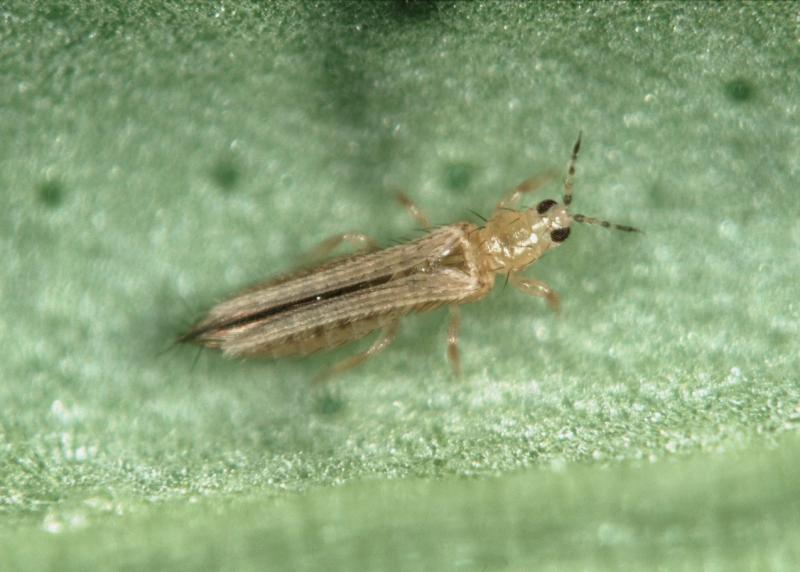
Caterpillars
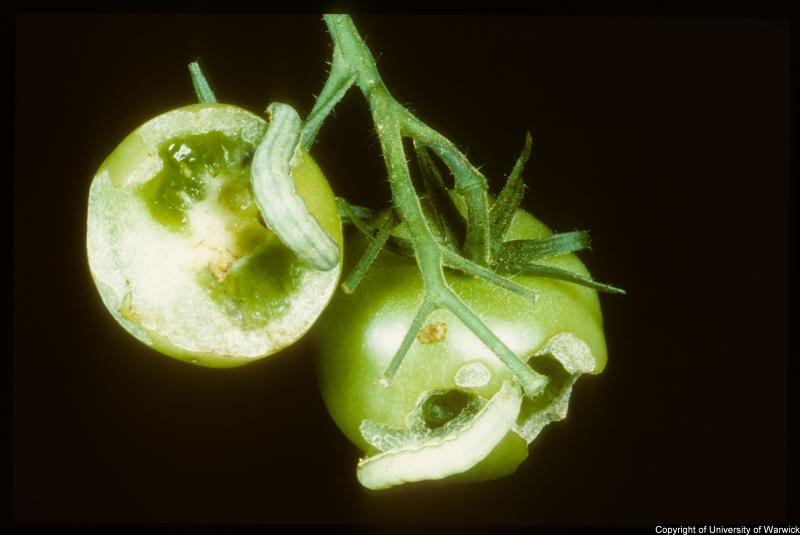
Several species of caterpillar affect glasshouse crops. Those of Tuta absoluta have been discussed separately. Tomato looper moth, (Chrysodeixis chalcites) and tomato moth (Lacanobia oleracea) are occasional problems and have been noted as issues in research projects. Careful inspection of crop damage, sticky traps and the early identification of larvae and moths will aid in quick control. There are parisitoids and predators that can be used at the egg stage if introduced early enough. Caterpillars can be controlled with applications of Bacillus thuringiensis but this material is most effective on early stage larvae. Populations can overwinter often in the pupal state and these can be on the plant or more commonly on the glasshouse structure itself.
Russet mite (Auculops lycopersica)
Another occasional sap sucking pest which can affect fruit, stems and leaves.
AHDB have not commissioned any specific research on this pest but a Factsheet 21/10, to help growers with detection of early symptoms has been produced. Russet mites can overwinter in plant material crevices and on alternative hosts. Eggs are invisible to the eye and can easily be missed in the clean-up.
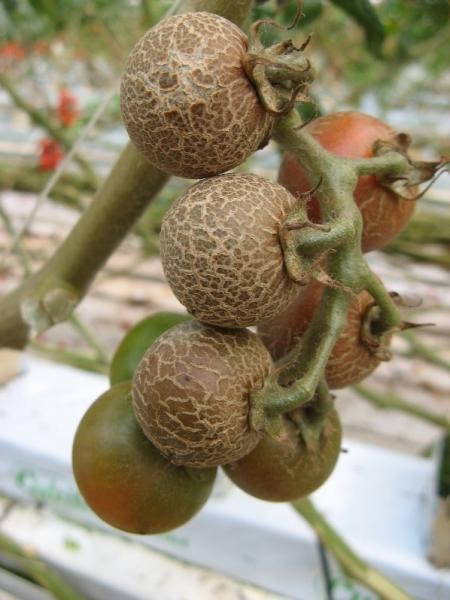
Images courtesy of:
- Glasshouse whitefly adult holds its wings flat at rest 20/15 - Control of whitefly in protected ornamental crops (BCP Certis)
- Winged aphid AHDB Crop Walker Guide (University of Warwick)
- Western flower thrips adult female 14/15 - Western flower thrips control in strawberry (Nigel Cattlin/FLPA Images of Nature)
Sectors:


